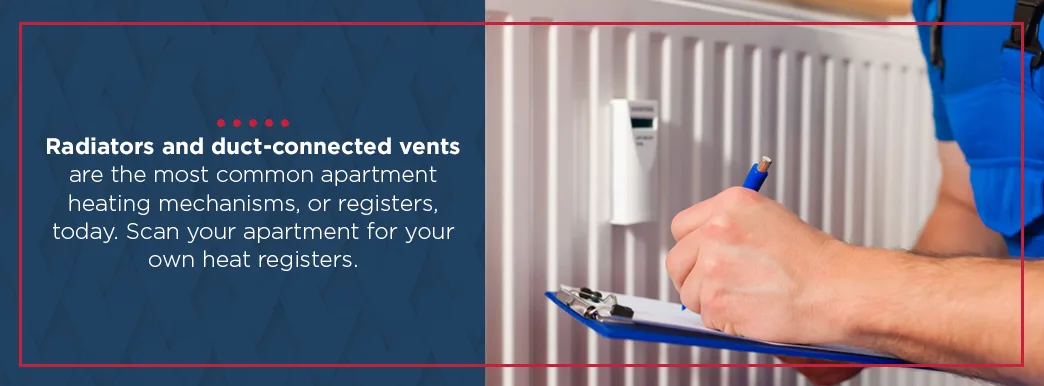

The arrival of winter means snow, chilly temperatures and higher heating bills. As a renter, you might think there’s nothing you can do to manage your winter heating bills in shared complexes. When you don’t own your home, how much can you really do to save money and lower those statements? Turns out, quite a bit.
Cut costs and save money on your apartment heating bills with these expert-approved tips.

Radiators and duct-connected vents are the most common apartment heating mechanisms, or registers, today. Scan your apartment for your own heat registers. Are radiators blocked off by couches, chairs, bed frames, desks or other furniture barring warm air from evenly spreading through the room? Likewise, are heat vents cleared and uninhibited, allowing maximum airflow?
Vents located near floor frames or above floor crown molding are particularly problematic. It’s easy for apartment furniture to block off floor-side air vents without you even noticing. This winter, harness your inner HGTV interior decorator and consider rearranging apartment furnishings for clear heat resister pathways.
Radiators emit heat in all directions — including the wall right behind it. Heat directed there does your apartment no good. Luckily, that’s where radiator reflectors come in.
These heat-resistant sheets slide behind radiators and the adjacent walls, redirecting warmth back into the room instead of being absorbed into the perimeter. Find heat-resistant reflecting sheets online or in your nearby hardware stores, where they run anywhere from $20-$40.
Do note that reflectors only work when stationed between a radiator and an exterior wall. Interior walls, such as those dividing rooms in your apartment, won’t contribute to total heat loss in the same way.

The age-old trick of using humidifiers in the winter does more than prevent dry skin and chapped lips. Humidity is also a heat amplifier.
Humid air traps and retains heat better than dry air. Adding a humidifier to your bedroom and living room will help regulate warmer temperatures, and will provide other benefits like less dry skin. Experts at the Department of Energy recommend measuring your apartment’s relative humidity levels. Optimal relative humidity readings for your home should be somewhere between 20-40%. When your home’s moisture levels are adequate, you can turn down your thermostat a few degrees without noticing a stark difference.
The curtains on your windows can help regulate the temperature in your home in a few ways. Here’s how to lower your heating bills in winter with curtains.
Bonus points here if you buy quilted curtains for your apartment. The thicker materials of quilted drapes are perfect to trap additional heat at night.

Take a look at your rental agreement, then ask your landlord if you can install a programmable or “smart” thermostat in your home. Programmable thermostats automatically adjust heat levels throughout the day based on the criteria you set.
With a programmable thermostat, you can set the heat to drop while you sleep, raise the temperature about an hour before you get up, lower it again when you leave for work, then warm up once more when you get home. Smart thermostats learn your habits and begin to do the programming for you. A pre-programmed heat moderator like this can trim 3-10% from your heating bills per degree lowered over 24 hours. That translates to saving around $100-150 per year.
The average home experiences heat loss between 25-30% of total heat usage. The main culprit? Old, unsealed or improperly locked windows.
Seal those heat-leaking panes properly with weatherstrips around windows, exterior doors and even attic hatchways. Use adhesive-backed weatherstrips for easy application, and make sure to clean all surfaces beforehand so the strips properly stick.
Storm windows are far more energy-efficient than draft-prone single panes. Storm windows have a double glass pane into all window units, one nestled into the interior of your home and one facing outdoors.
The double-pane helps seal out cold winter air, preventing it from ruining your cozy temperatures. However, not all storm windows are made equal. Check the condition and weatherability of yours, paying special attention to the locks. The panes should also close airtight.
If your apartment doesn’t have double-paned storm windows, consider making your own by applying plastic wrap over your windows to create that second layer.

Keeping doors open throughout the day may not seem like a heat waster. Yet closing the doors to individual rooms helps to seal warmth inside. It’s an intuitive and easy trick, especially in larger apartments with multiple bedrooms.
Use similar logic for rooms that aren’t frequently occupied. You can even consider gradually lowering the thermostat throughout your apartment, using your closed doors to block and trap in the existing warm air even as temperatures fall.
Does your apartment have a wood-burning fireplace? If so, make sure to regularly close the damper every time the fireplace isn’t in use. Just make sure to open it back up before you light your next fire.
Chimney dampers are located near the smoke-collecting deck, typically in the mid-section of your chimney chute. Wood-burning fireplaces will have a small latch located around the mantle that closes and opens the damper flap. Leaving the damper open 24/7/365 is akin to keeping your apartment windows open all year round. Warm air will continually escape through the chute, letting cool air flood in.
Use the same logic to check your dryer vents. Dryer vents should also be closed off when not in use to keep heating bill expenses air-tight.
Continually shutting off and restarting your heat is actually more expensive than adjusting the temperature in your home. While turning off the heat seems like the most direct (and even intuitive) way to save money on your bills, you end up shelling out more in the rebooting process.
As a rule of thumb, refrain from shutting off your heat frequently. If you’re going away for and extended period, the thermostat way down, but not off, so that pipes don’t freeze.

Windows should lock securely and smoothly. Those that jam or get caught as you try securing them into place are likely letting warm interior air escape from your home. Faulty locks also let in the dry, cold winter air.
Reach out to management if the windows in your home don’t lock properly. Issues that are worth connecting with your landlord over include jammed locks and windows that are difficult to pull down or don’t seem to sit right in the frame. Again, unsealed edges on windows are the number one reason homes lose heat in the winter, siphoning up to 20% of your warm air.
Sorry, barefoot lovers. Winter is not the time to prance around the home like it’s an afternoon at the beach. In fact, feet are particularly triggering temperature points for the body. Cold feet make it difficult for other parts of the body to feel warm. As a result, you’ll feel chilled in your apartment even if thermometer settings are at a comfortable level. Set a house rule that everyone must be wearing socks, pants and long sleeves before even considering cranking up the heat. Even then, you can always toss on a thicker layer or a blanket.
Your apartment’s exterior heating unit must be in good condition to produce and maintain proper heat levels for the entire building. Take a few minutes to quickly inspect that unit. Ensure nearby brush is well-trimmed and any material obstructions removed. Overgrown plants, snow buildup or basic debris can block the unit and prevent it from functioning correctly. If possible, you can also go the extra mile by inspecting the condition of heat pumps weaving throughout accessible apartment areas, such as in your building’s basement. Just be sensible. Don’t creep out your neighbors.

Standalone and ceiling fans are most popular in the summer, helping create a cooling effect by circulating air throughout a room. Many ceiling fans have a reverse function, which rotates the blades clockwise. The reversed motion actually draws cold air upward while pushing the naturally rising hot air back down, helping your home feel warmer.
Similar products exist to help draw even more cold air from a room. For example, air-vent boosters can be installed over individual vent openings to create cold-air-targeting updrafts. Installing these devices can reduce heat bills even further because you won’t have to set your thermostat so high.
Forget spring cleaning: The cooler months leading up to winter are a great time to give your apartment’s HVAC components a little love. Dust off radiators and vent openings, especially those near floor baseboards. Clean window panes for airtight closing and locking. These small actions not only keep heat components in prime condition — they improve apartment air quality, making your home healthier.

Some ideas seem like they would help to lower your heating bill, but don’t do much at all, or make the problem worse. When aiming to lower your apartment’s heating bills, take care to avoid these mistakes.
Every degree you lower your thermostat means a 1% decrease in total energy usage. Those are significant savings — plus an act bringing several other benefits to you and your home. The National Sleep Foundation recommends bedroom temperatures around 65°F for optimal sleeping at night. That’s roughly on par with the Department of Energy’s own thermostat adjustment range, which suggests 68°F if you’re home throughout the day and a few degrees cooler at night.
You’ve probably heard half a dozen ways to help heat your home that doesn’t involve cranking up the thermostat. But are these hacks sound science or old wives’ tales?
Turns out, they’re mostly the latter. Popular alternative home heating methods, like those below, tend to backfire in the long run when people turn to them for warmth.
This one’s a huge no-no — yet something apartment dwellers can easily turn to when penny-pinching during winter.
Turning off your heat can trigger a series of issues in your plumbing pipes. If you live in a particularly cold state, those pipes may even freeze, requiring a plumber to come on-site and unthaw. Worst case scenario, the pipes burst.
Fixing burst plumbing pipes can easily run you thousands of dollars. What’s more, fully turning off your heat in the first place may, in fact, be a violation of your renter’s agreement, meaning you’re strapped with full liability and left to foot the bill. Flooding from pipes will also likely damage others’ apartments and belongings, which you’ll also be liable to cover.
Avoid all this by simply turning down your thermometer, never shutting it off all the way.
Electric heaters can provide a convenient relief for particularly cold or drafty spots in the home. However, there is a downside: the cost of the electricity itself.
Electricity prices vary widely across the country. Some residents, such as those living in New England states like Massachusetts and Rhode Island, will pay almost double per kilowatt-hour than residents in other regions. In Pennsylvania, rates are slightly above the national average, around 13.8 cents-per-kilowatt hour.
What does all this mean when it comes to lowering your heating bills? Using electric heaters may technically cut that gas bill — but require spending disproportionately more on electricity. In other words, depending on where you live, it makes more sense to spend money on gas-based heating (i.e., HVAC) than on spot heating (i.e., electric heaters). Check out your local gas versus electricity rates to make the best decision for your home.

Creating a monthly budget is smart. Budgets bring stability to your spending habits. They help you avoid feeling guilty about your spending or living beyond your means.
While gas bills are a variable expense and will fluctuate depending on the time of year and usage, get a reliable sense of heating costs for your budget by using these best practices.
Many municipalities have payment estimate plans which take the guesswork out of your monthly gas expenses. Using energy cost estimates and regional data, gas companies calculate your annual gas payment, then prorate that payment evenly across twelve months. You know the exact amount on your bill each and every month, no surprises. At the end of the year, your company then reviews actual gas prices against their projection and will credit you the price difference, if one exists.
Natural gas and electricity prices vary widely across the country. Again, depending on where you live, it may be more cost-effective to supplement gas-based heating with electric space heaters. On the flip side, you may be throwing away money by using electric heating equipment in the first place. Find out your area’s rates to be sure.
Turning down your water heater requires a little coordination. It’s an ideal choice for smaller apartment buildings with only a few homes inside, but must be cleared by management, other tenants and explicitly allowed by your lease.
However, if possible, lowering your water heater’s temperature can save you and your neighbors money by reducing total building energy consumption by 4-22%. Most manufacturers program their water heater’s temperatures at 140°F. At this temperature, bacteria and other germs are killed off, purifying the water. However, water as low as 120°F will still kill off pathogens, is safe to use and will reduce your building’s total gas and heating costs.
Open-concept apartments are harder to heat. While still one of the trendiest design and architectural styles of the moment, open floorplans remove the interior walls and barriers so necessary to trap and retain heat.
Other apartment styles risk similar heating issues. High, cathedral-style ceilings, converted warehouses, lofts and older buildings each tend to have a harder time dispersing heat evenly throughout the space. In the winter, these layouts can make your apartment feel many degrees cooler, even when the thermostat is set to a toasty temperature.
If apartment heat and gas bills are a top concern, don’t house hunt for open-concept apartment layouts. Stick with more traditional, multi-room setups with clear walled boundaries between the kitchen, living room, dining area and bedrooms.
The short answer? It depends.
The long answer? It still depends.
Apartments advertising “heat included” do so after considerable calculations. Often, rent will be adjusted to reflect the average heating cost. Landlords or building managers will work bill totals from previous years into upcoming rent prices, using the previous year’s gas expenditures or even rounding up estimates to cover particularly cold winters. In either situation, “heat included” is certainly convenient — it’s one less variable expense and one less bill you need to arrange. Yet often, it’s a calculated decision pre-determined by owners to keep properties marketable and profitable.

You take pride in managing your money — and the peace of mind it brings. Keeping your heating costs low in the winter can feel like a badge of honor, allowing you to spend your money how and where you actually want.
Keep up-to-date on other money-saving tips when renting by following our Triple Crown Corporation Blog. You can also reach out directly to ask questions about renting in central Pennsylvania. We’d love to connect and help you make your best rental decisions!